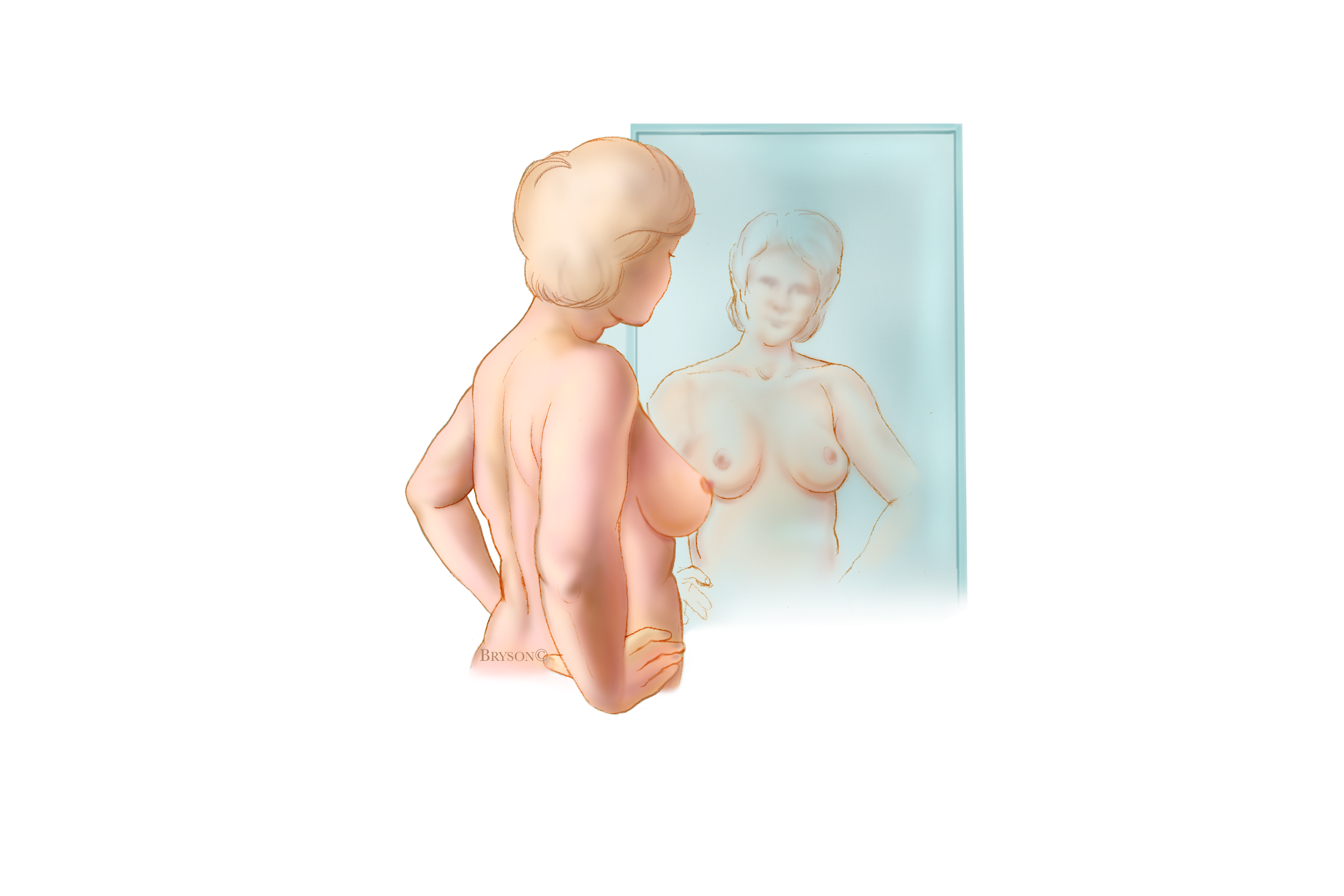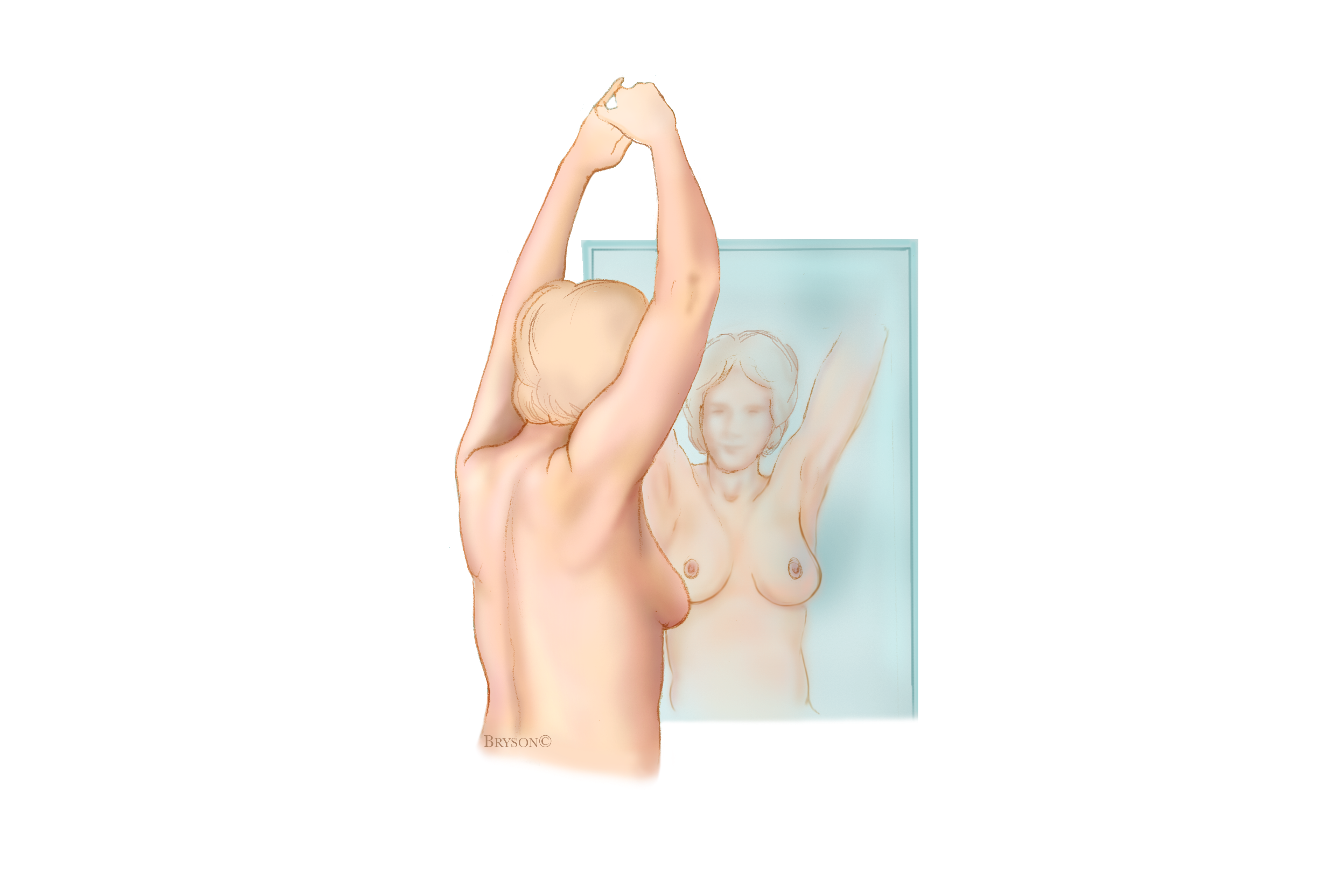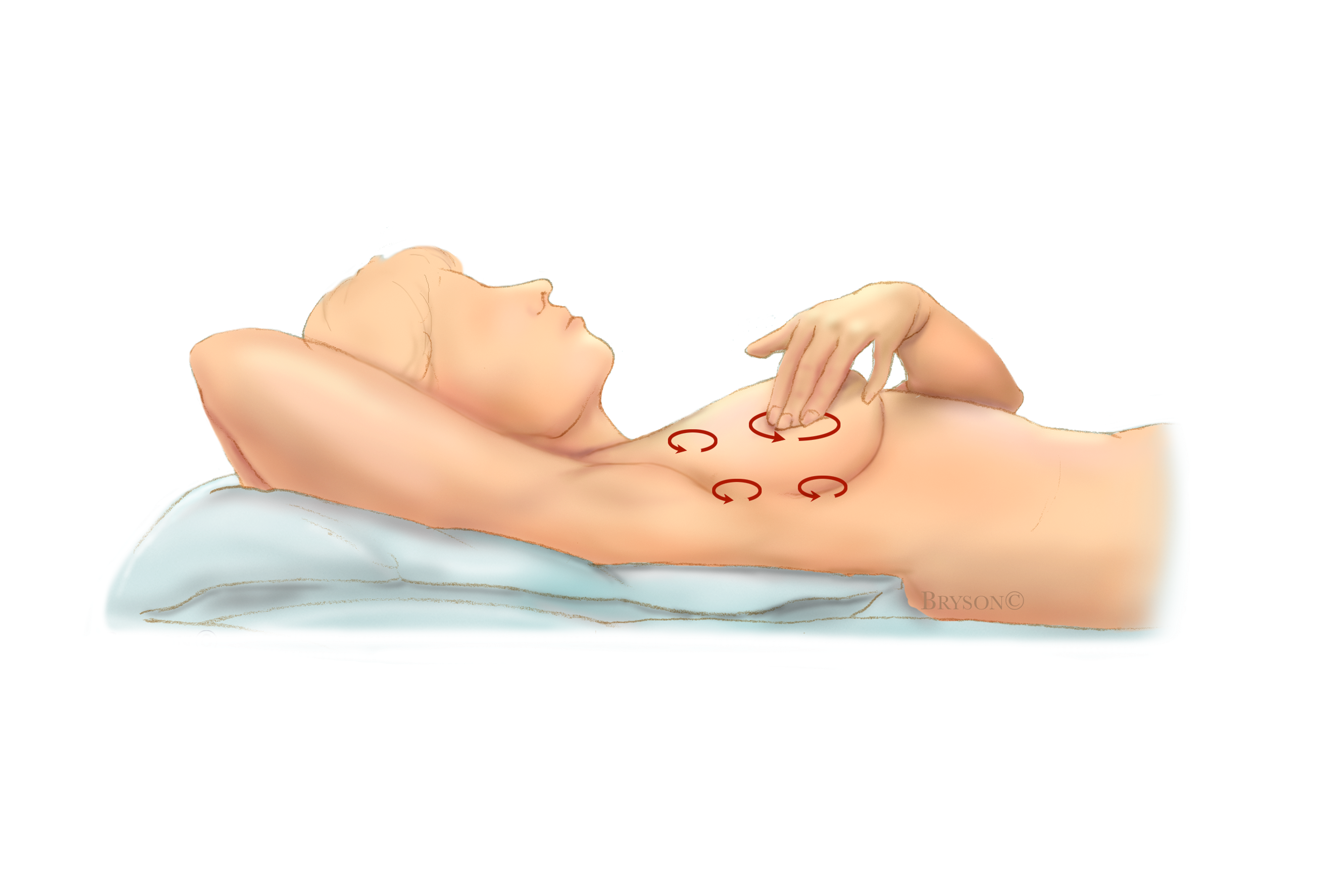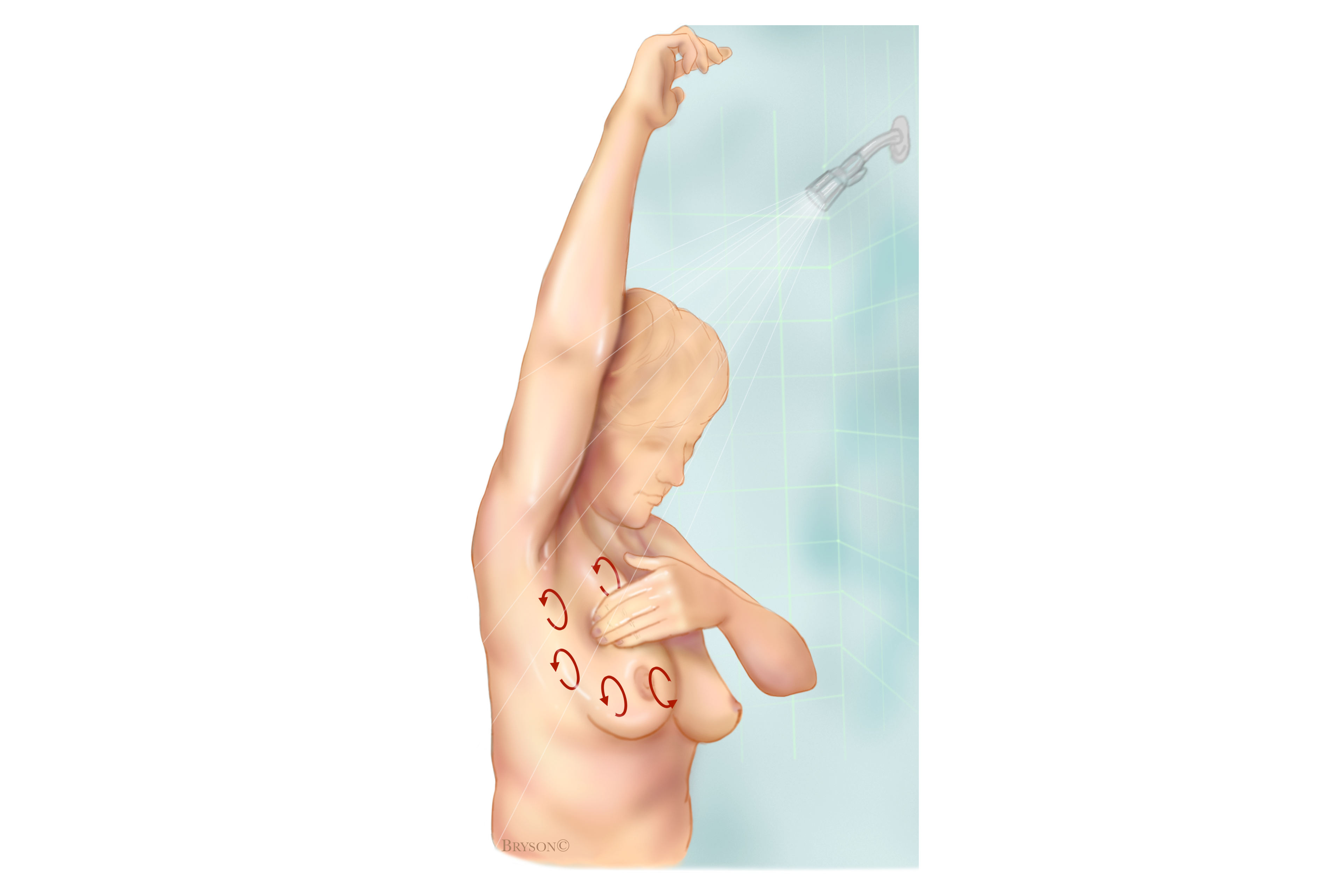
Breast self-exam, or regularly examining your breasts on your own, can be an important way to find breast cancer early, when it’s more likely to be treated successfully. Although no single test can detect all breast cancers early, many people report that performing a breast self-exam in combination with other screening methods can increase the odds of early detection.
Through the years, there has been some debate among medical experts about how valuable breast self-examination is in detecting breast cancer early and increasing the likelihood of survival. For example, a 2008 study of nearly 400,000 women in Russia and China reported that breast self-examination does not have a meaningful effect on breast cancer survival rates and may even cause harm by prompting unnecessary removal and examination of suspicious tissue (biopsies). In response to this study and others like it, the American Cancer Society stopped recommending breast self-exam as a screening tool for women with an average risk of breast cancer.
Still, at Breastcancer.org we recognize that breast self-examination can be a useful and important screening tool, especially when combined with:
-
regular physical exams by a doctor
-
mammography
-
ultrasound, MRI (magnetic resonance imaging), or both
Each of these screening tools works in a different way and has strengths and weaknesses. Breast self-exam is a convenient, no-cost tool that you can use on a monthly basis and at any age as part of your overall breast cancer screening strategy.
How to do a breast self-exam: Five steps for checking for breast cancer at home

Step 1: Examine Your Breasts in a Mirror With Hands on Hips
Begin by looking at your breasts in the mirror with your shoulders straight and your arms on your hips.
Here’s what you should look for:
-
Breasts that are their usual size, shape, and color
-
Breasts that are evenly shaped without visible distortion or swelling
If you see any of the following changes, bring them to your doctor’s attention:
-
Dimpling, puckering, or bulging of the skin
-
A nipple that has changed position or an inverted nipple (pushed inward instead of sticking out)
-
Redness, soreness, rash, or swelling

Step 2: Raise Arms and Examine Your Breasts
Now, raise your arms and look for the same changes.
Step 3: Look for Signs of Breast Fluid
While you’re at the mirror, look for any signs of fluid coming out of one or both nipples (this could be a watery, milky, or yellow fluid or blood).

Step 4: Feel for Breast Lumps While Lying Down
Next, check for breast lumps or abnormalities by feeling your breasts while lying down, using your right hand to feel your left breast, and then your left hand to feel your right breast. Use a firm, smooth touch with the first few finger pads of your hand, keeping the fingers flat and together. Press down with your fingers and move them in a circular motion that’s about the size of a quarter (or an inch around).
Cover the entire breast from top to bottom, side to side — from your collarbone to the top of your abdomen, and from your armpit to your cleavage.
Follow a pattern to be sure that you cover the whole breast. You can begin at the nipple, moving in larger and larger circles until you reach the outer edge of the breast. You can also move your fingers up and down vertically, in rows, as if you were mowing a lawn. This up-and-down approach seems to work best for most women. Be sure to feel all the tissue from the front to the back of your breasts: for the skin and tissue just beneath, use light pressure; use medium pressure for tissue in the middle of your breasts; use firm pressure for the deep tissue in the back. When you’ve reached the deep tissue, you should be able to feel down to your ribcage.

Step 5: Feel Your Breasts for Lumps While Standing or Sitting
Finally, feel your breasts while you are standing or sitting. Many women find that the easiest way to feel their breasts is when their skin is wet and slippery, so they like to do this step in the shower. Cover your entire breast, using the same hand movements described in step 4.
What to do if you find a breast lump
Don’t panic if you think you feel a lump in your breast. Most women have some lumps or lumpy areas in their breasts all the time, and most breast lumps turn out to be benign (not cancer). There are a number of possible causes of non-cancerous breast lumps, including normal hormonal changes, a benign breast condition, or an injury.
Don’t hesitate to call your doctor if you’ve noticed a lump or other breast change that is new and worrisome. This is especially true for changes that last more than one full menstrual cycle or seem to get bigger or more prominent in some way. If you menstruate, you may want to wait until after your period to see if the lump or other breast change disappears on its own before calling your doctor. The best healthcare provider to call is the one who knows you and has done a breast exam on you before — for example, your gynecologist, your primary care doctor, or a nurse practitioner who works with your gynecologist or primary care doctor.
Know what to expect. At an appointment to evaluate a breast lump, your doctor takes a health history and does a physical exam of the breast, and most likely orders breast imaging tests. Ultrasound is often the first or only imaging test used to evaluate a lump in women who are younger than 30 or are pregnant or breastfeeding. Both an ultrasound and a mammogram are typically recommended to evaluate a lump in women who are older than 30 and not pregnant or breastfeeding. If further testing is needed, your doctor may recommend additional imaging with MRI, MBI (molecular breast imaging), a biopsy, or any combination of these tests. Your doctor may also refer you to a breast specialist (typically, a breast surgeon) for further evaluation.
Make sure you get answers. It’s important that your doctor explains what is causing the lump or other breast changes and, if necessary, develops a plan for monitoring it or treating it. If you’re not comfortable with your doctor’s advice, don’t hesitate to get a second opinion.
How to make breast self-exam part of your breast cancer screening strategy
Make it routine. The more you examine your breasts, the more you can learn about them and the easier it can become for you to tell if something has changed. Try to get in the habit of doing a breast self-examination once a month to familiarize yourself with how your breasts normally look and feel. Examine yourself several days after your period ends, when your breasts are least likely to be swollen and tender. If you are no longer having periods, choose a day that’s easy to remember, such as the first or last day of the month.
Get to know your breasts’ different “neighborhoods.” The upper, outer area — near your armpit — tends to have the most prominent lumps and bumps. The lower half of your breast can feel like a sandy or pebbly beach. The area under the nipple can feel like a collection of large grains. Another part might feel like a bowl of lumpy oatmeal.
Start a journal where you record the findings of your breast self-exams. This can be like a small map of your breasts, with notes about where you feel lumps or irregularities. Especially in the beginning, the journal may help you remember, from month to month, what is normal for your breasts. It is not unusual for lumps to appear at certain times of the month and then disappear as your body changes with the menstrual cycle (if you are still menstruating).
Breast and chest self-exams for trans and nonbinary people
Though the research is very limited, transgender men and women who have breast tissue are thought to be at a higher risk for breast cancer than cisgender men. Because of this, they may also consider performing breast or chest self-examinations on a monthly basis, although some medical guidelines recommend against this practice for transgender individuals.
Although transgender men and non-binary people assigned female at birth may experience gender dysphoria when conducting self-examinations, following recommendations for breast cancer screening is the best way to protect yourself. Crucially, chest masculinization surgery does not remove all breast tissue, so even transgender people who have this surgery are at risk for breast cancer and should consider chest self-examinations.
Symptoms associated with feminizing hormone therapy — such as breast pain, tenderness, and nodularity — may prompt transgender women and non-binary people assigned male at birth to perform overly frequent breast self-examinations, according to the University of California, San Francisco. Be aware that these symptoms may simply be due to breast growth, and talk to a medical provider if you are concerned
Mayo clinic.com

More importantly, to stay updated with the latest news, health updates, happenings, and interesting stories, visit thescopermedia.com








